IN THIS ISSUE
- Exploring state's fireflies
- Eagle nesting stays strong
- Wild tegu sightings spike
- Shoddy nest, successful bird
 Firefly collected during a Georgia survey (Caitlin Lyons/DNR)
Fireflies dotting summer nights with flashes of light is a common sight. This is especially true in Georgia, which is home to over 50 species of lightning bugs, more than any other state.
Yet while fireflies may seem plentiful, they face significant threats. To better understand and conserve these enchanting insects, DNR is gathering data on firefly species and populations.
In this two-part blog series, DNR’s Caitlin Lyons joins a survey and quizzes wildlife biologist Anna Yellin on what’s at stake.
INVERT INSIGHTS
Recent firefly surveys involving DNR’s terrestrial invertebrates team ranged from Sandy Creek Nature Center to Piedmont National Wildlife Refuge and a beaver pond near Lake Hartwell. Rare loopy 5 fireflies were found at a few sites.
Staff also collaborated with other researchers and enthusiasts, including author and consultant Lynn Faust, University of Colorado associate professor Orit Peleg and science communicator Emily Graslie of The Brain Scoop.
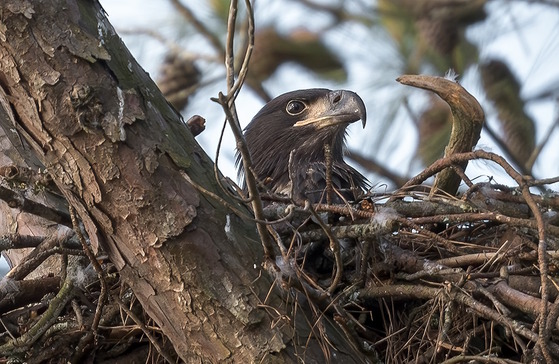 Juvenile bald eagle at a north Georgia nest this year (Becky Cover)
Go, eagles!
Cheering on a sports team? Nope, celebrating Georgia’s bald eagles, which just posted another strong nesting season.
DNR’s annual check of eagles nesting in the state found nest totals and success rates for the national symbol at or above average, according to survey leader Dr. Bob Sargent.
“The findings were even better than last year’s good results,” Sargent said. “That’s most encouraging when you consider the beating that nesting coastal eagles took in 2022 because of an outbreak of highly pathogenic avian influenza.”
Accounting for nests not surveyed this year, the survey results suggest Georgia has maintained over 200 nest territories a year since 2015, while the number of eagles nesting here continues to increase.
More in today's news release.
2024 NEST NUMBERS
- Occupied bald eagle nest territories: 145*
- Successful nests: 116
- Young fledged: 178 (1.53/nest)
- New nests (first time surveyed): 21
- Overall nest success rate: 80%
*In areas surveyed (not statewide)
WHAT YOU CAN DO
DNR's Wildlife Conservation Section depends mainly on grants, fundraisers and donations to conserve eagles and other native wildlife and habitats. Want to help?
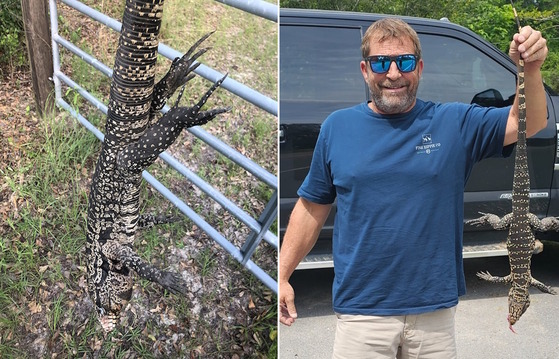 Tegus taken, left, near I.S. Smith Road by Seth Edwards' crew and by Zack Bowen on Ga. 147 (Special to DNR)
If you thought wild tegus were no longer an issue in Tattnall and Toombs counties, think again. Four Argentine black and white tegus were recently reported, on both sides of the county line.
Mendes resident Seth Edwards had a crew raking pine straw off I.S. Smith Road in eastern Toombs County when the leader called him on May 20. He was excited.
“He said, ‘We killed a dragon!’” Edwards recalled. “I said, ‘A what?’ He said, ‘A dragon … a big lizard!’”
That tegu, caught as it scrambled for a gopher tortoise burrow, measured more than 3.5 feet long. Meanwhile, just east across the Ohoopee River in Tattnall County, Reidsville landowner Zack Bowen killed a 28- to 30-inch tegu on Ga. 147. Zack Bowen spotted the lizard crossing the road near his driveway May 24.
The tegus were the first confirmed in the region this spring, although a handful of unconfirmed yet credible sightings have also been reported.
Argentine black and white tegus, the world’s largest tegu, are native to parts of South America and invasive in Georgia. Growing up to 4 feet long and weighing 10 pounds or more, they eat everything from bird eggs to small animals and plants.
The state’s only known wild population of tegus is in Toombs and Tattnall.
More in this update.
SEE A TEGU, TELL DNR
- Let DNR know when you spot a tegu in the wild, alive or dead. Note the location, take a photo if possible and report the sighting online or by phone (478-994-1438) or by email.
- As a non-native species, tegus in the wild in Georgia are not protected by state wildlife laws or regulations. They can be trapped or killed year-round on private land with landowner permission and in accord with animal cruelty regulations, local ordinances and appropriate safety measures.
- If you have any exotic pet, don't let it loose. It is illegal to release a non-native animal into the wild without a permit.
- Details at georgiawildlife.com/tegus.
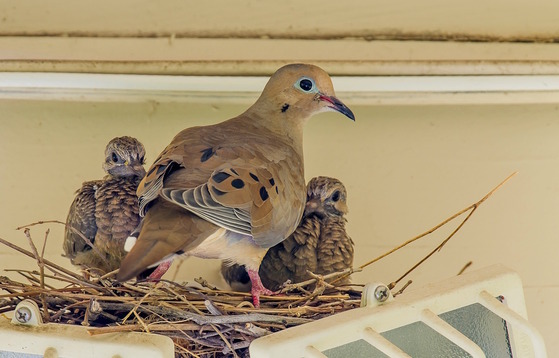 Dove nest on outdoor lights (Adobe Stock)
By TERRY W. JOHNSON
There are many reasons why mourning doves are extraordinary.
For example, they are the only bird species native to the U.S. that breeds in all 50 states. They’re also one of our most abundant birds – numbering an estimated 400 million – as well as our most popular game bird.
All of this is even more remarkable when you consider that mourning doves build the flimsiest nests imaginable. They will also nest just about anywhere, from stumps and hanging baskets to shrubs and air conditioning units. …
Read Terry’s column for details on doves' shoddy and unusual nesting practices.
Terry W. Johnson is a retired DNR manager and executive director of TERN, friends group of the Wildlife Conservation Section. Check out past columns and his blog. Permission is required to reprint a column.
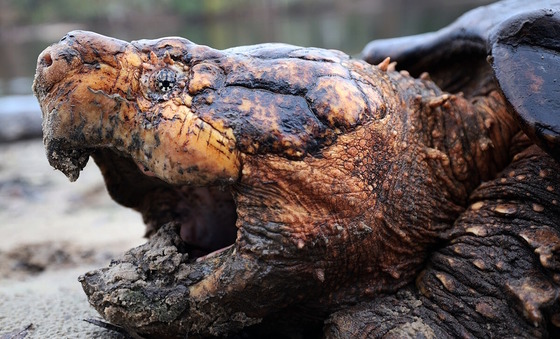 Suwanee alligator snapping turtle (Renee Bodine/USFWS)
Listing Suwannee alligator snapping turtles as threatened under the Endangered Species Act is aimed at helping these prehistoric-looking reptiles persevere for centuries more. Alligator snapping turtles are North America’s largest freshwater turtles, growing up to 200 pounds and almost 3 feet long. Georgia is home to both gator snapper species – Suwannee and western – but Suwanees are limited to the Suwanee River drainage in south Georgia and north Florida. Threatened by illegal harvest, hook ingestion, incidental catch by anglers and nest predation, only about 2,000 of these turtles are left, according to the U.S. Fish and Wildlife Service. DNR will restart surveys for the species this month, building on previous work probing the precarious status of Suwannee gator snappers.
Sea turtle season on Georgia’s coast is shifting from nesting to hatching. With Sea Island reporting the first hatch July 2, some loggerheads continue to lay eggs, with the nest total over 2,070 and about 3,000 predicted, slightly fewer than last year. How beachgoers can help protect sea turtles.
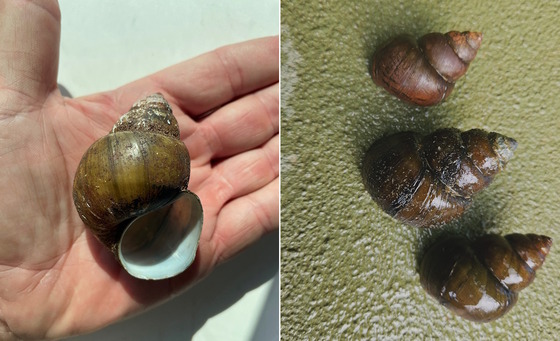 Japanese mystery snails (Jim Page/left; Matthew Rowe/right/DNR)
A population of Chinese or Japanese mystery snails has been confirmed in Lake Lanier, the latest advance in Georgia for these invasive snails from Asia. Although popular for aquariums and in some food markets, live mystery snails are illegal in the state and DNR is asking anglers and boaters to help prevent their spread.
Caught a tagged blue catfish on the Satilla River? Report it to DNR and claim a custom cap. For the second straight year, a tagging project is helping biologists gauge how these big catfish that aren’t native to the Satilla are growing, spreading and possibly affecting native fisheries in the southeast Georgia river.
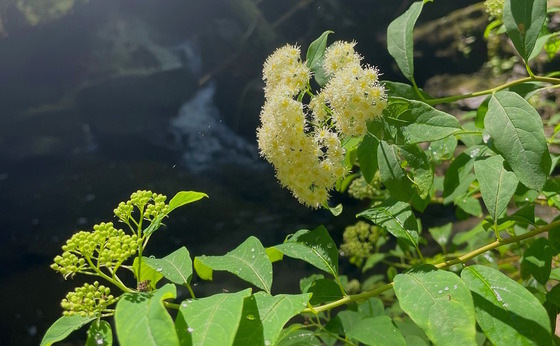 Virginia spirea blooming in a northwest Georgia canyon (Stephanie Koontz/DNR)
Rare plant searches have uncovered some gems in Georgia. Finds involving hawthorns – diverse but often missed – include downy hawthorn (Crataegus mollis), not seen in the state for 20 years, and valley head hawthorn (Crataegus austromontana), which still needs confirmation for a species presumed extinct. Also, in a northwest Georgia canyon where Virginia spirea (Spiraea virginiana) had been documented at one site, DNR staff scoured the rugged canyon to discover another stand of the endangered streamside plant.
The red-cockaded woodpecker story at Sprewell Bluff Wildlife Management Area keeps getting better. Not only did two of the three pairs moved from Fort Stewart last fall nest and raise young, at least another of the endangered birds is still on the WMA near Thomaston and staff might have glimpsed the sixth.
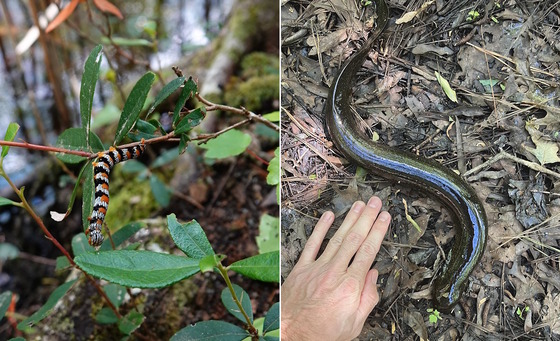 Tuckahoe WMA wildlife: Okefenokee zale moth caterpillars and a greater siren (Matthew Moore/DNR)
Quick hits:
- Surveys at Tuckahoe Wildlife Management Area in Screven County have turned up two giant salamander species – greater siren and two-toed amphiuma – and caterpillars of the globally rare Okefenokee zale moth.
- A striped dolphin that washed up on Sea Island last month, the first report of this species stranding in Georgia, provided a learning opportunity for Savannah State University students in the school’s Dolphin Sciences Laboratory to help DNR necropsy the carcass.
- Texas has confirmed its first tri-colored bat with white-nose syndrome, while three other species that tested positive for the fungus that causes the bat-killing disease included canyon bats, possibly a first for the U.S.
- This year’s Georgia Teacher Conservation Workshop took 25 educators through five days of professional development focused on forestry, natural resources management and how the two realms connect.
- Be BearWise when you camp, cooking far from your tent, storing food appropriately and keeping food, trash, toiletries and clothes worn while cooking someplace other than your tent.
 Camp TALON group (DNR)
Names in the news: 21 teenagers from five states – the farthest away: Washington – took part in last month’s coast-based Camp TALON (Teen Adventures Learning about Ornithology and Nature). Led by DNR’s Dr. Bob Sargent and Linda May, and with partners varying from Little St. Simons Island staff to retired professors Bob Sattelmeyer and Bob Cooper, the teens toured top birding sites, exploring ornithology, natural habitats, beach invertebrates, conservation careers and other wildlife-based topics. DNR Deputy Commissioner Trevor Santos and Wildlife Conservation Section Chief Matt Elliott helped celebrate Athens-Clarke County’s completion of Restore Our River: Phase 2, a Georgia Outdoor Stewardship Program grant-funded project that targeted 70 acres along the North Oconee River for invasive plant control, stream bank restoration, park facility upgrades and installation of two “trash traps” in Trail Creek.
WHAT YOU MISSED ...
In the previous Georgia Wild:
- Death in a shorebird colony
- Augusta sturgeon saved
- Hummers with sniffers
- Georgia’s first flamingos
"Invasive mystery snail discovered in Lanier," WAGA-TV (ch. 5, Atlanta), plus WSB-TV (ch. 2, Atlanta), The (Gainesville) Times and others
(+video) "Young right whale seen entangled in Gulf of St. Lawrence," Canadian Broadcasting Co. Also: "Another calf presumed dead after adult carcass found," CTV News (Toronto); "Environmental groups decry attempt to delay shipping rules," The Associated Press; "Once entangled whale seen swimming free," CBC
(+video) "Georgia ‘T-Rex of turtles’ added to U.S. threatened species list," WSB-TV (ch. 2, Atlanta). Also: Atlanta Journal-Constitution.
"Extension, Fannin County partner to conserve fireflies," The Georgia Virtue
(+video) "Tree cutter saves entangled raptor," WXIA-TV (ch. 11, Atlanta)
"Return of an endangered bird and its habitat," Atlanta Journal-Constitution
"Warmer weather means increase in wildlife sightings," The Augusta Chronicle
"Rodenticide played part in Flaco the owl's death," American Bird Conservancy
"Georgia funds $7 million renovation of historic Ossabaw home," Georgia Public Broadcasting
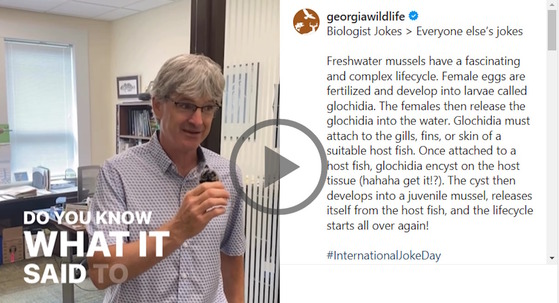 Didja hear what the mussel said to the bass? DNR's Brett Albanese on Instagram
(audio) "Save the Snakes," Orianne Society "Snake Talk" podcast
DNR game wardens: Don't boat under the influence, DNR
Monitoring sicklefin redhorse, DNR
"Second Catch," Take Me Fishing
"Flyways," Nature episode on the challenge of conserving shorebirds, PBS
Tug sunk as new habitat for marine life, DNR Coastal Resources Division
"Team frees young humpback whale off Massachusetts," CBS News
"Remastered footage of dynamite used to blow up stranded whale," MSN
"A Model Toadlet," work involving disease decimating amphibians, bioGraphic
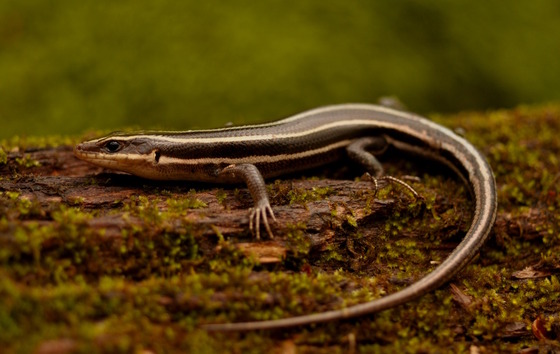 Five-lined skink (Mark Krist)
If you have rotting logs, stumps or rocks in your yard, you probably have five-lined skinks. After breeding in the spring, the female lays four to 14 eggs and guards them until they hatch in early summer. The young have bright blue tails with five white or yellowish stripes down the length of their black bodies. At maturity, the lizards will be 5 to 8½ inches long and completely gray or beige with faded lines. To escape predators, skinks run fast and have tails that break off if need. The lost-tail survival trick works but means a loss of stored fat and protein until the tail grows back. (For another common but unique lizard, read the “Fast, Flashy, Savvy” blog post.)
- Linda May
CREDIT
Masthead: bald eagle (Tom Wilson/Georgia Nature Photographers Association)
Top
|